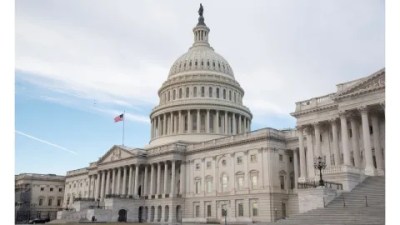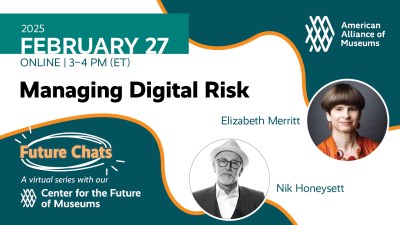
In recent weeks, museum leaders have often been forced to make decisions on the fly, in advance of crafting a comprehensive (or even a tentative) plan for coping with the current tsunami of change. That being so, I’m working on a series of essays on how museums might navigate this situation on a day-to-day basis. Last month I suggested three first steps museums and museum people might take in the face of rapid change. (TLDR version = take care of yourself, focus on a manageable number of credible news sources, and sort news by its potential impact on you and your organization as well as your ability to do anything about it.) This week I’m going to offer some thoughts on creating a context for risk assessment, and how that might inform decisions on when and how to take action.
Assessing Risk
So much of what is happening falls outside our realm of personal experience, it can be hard to make rapid, intuitive judgements about risk. When faced with the current spate of EOs and announcements, it may feel natural to focus on the potential risks of noncompliance. However, it is useful to remember that there is actually a spectrum of risk:
- At one end are potential legal or financial actions, by the government or nongovernmental groups, that might damage an organization.
- At the other end, preemptive compliance (or as some have called it, “anticipatory obedience”) can pose a risk to reputation, to the ability of an organization to deliver on its mission, and to its duty of care for its staff and its community.
It is also important to consider the cumulative impact of individual or organizational actions on society. Decisions that keep us safe, individually and institutionally, in the short term may over the long term collectively create undesirable futures. For example, self-censorship of content might help an organization avoid unwanted attention in the current political climate, but what kind of future would widespread self-censorship help to create?
Asking Questions
How can you make wise decisions within the context of this whole spectrum of risk? One approach is to start with a framework of questions that can help tease out potential consequences of action or inaction. For example, here are some questions I’ve been hearing museum leaders ask as they consider how to respond to the expanding list of Executive Orders affecting charitable nonprofits. (Prefacing with the disclaimer that I am not an expert in either legal or legislative issues, I’m just outlining the issues as I’ve heard them discussed.)
- Does a given EO apply to our organization? Some EOs are directed at specific businesses that receive federal funding or a federally regulated. For some museums this may be a clear “yes”: for example, if their governing authority is part of the federal government, or if they receive grant funding from a federal agency. On the other hand, as we saw with the implementation of the Native American Graves Protection and Repatriation Act, “federal funding” finds its way to museums through a wide variety of channels.
- Is the guidance in a given EO clear and consistent? The wording of some of the EOs so far have been vague, and in some cases conflict internally or with subsequent communications, making it difficult to determine what organizations they apply to, or what compliance they are trying to mandate. For example, the EO Executive Order “Ending Illegal Discrimination and Restoring Merit-Based Opportunity” names accessibility (as part of DEIA) as a preference that “can violate the civil-rights laws of this Nation”. However, it’s not clear whether the EO is actually targeting accessibility, or, if it is, whether that would stand up to constitutional challenge. (Disability rights lawyer Eve Hill thinks not.)
- Is it possible the EO may be challenged in court? (Many of them already have.) It may take some time for these challenges to wend their way through the system to determine whether they are eventually implemented. This being so, might it be prudent to wait and see, before taking any actions, absent an immediate threat?
- Are the consequences spelled out? The EO “Ending Illegal Discrimination and Restoring Merit-Based Opportunity” requires each federal agency to “identify up to 9 potential civil compliance investigations of corporations, large nonprofits or associations, or foundations with assets of $500 million or more.” Some museums fall into that asset category, but what are the implications of these “potential civil compliance investigations?”
More generally (not EO specific)
- When might “taking a stand” make a difference, and when might it put an organization, and its staff and audiences, at risk? If both, how do you weigh the benefit and harm of these impacts?
- What are the values, and opinions, of our museum’s key stakeholders (board, staff, funders, donors, and community members), and how do they support or conflict with pressure from the government, funders, donors, and activists to behave in certain ways?
It also may be useful to set aside questions that might not provide useful answers, for now. For example:
- Many legal scholars are weighing in on whether any given action will hold up in court, asking “does the government have the power to do this?” Even a consensus on these issues might not provide useful guidance, as the administration may not comply with court rulings. For example, this week the administration announced it would defy a court order to prevent the funding freeze at the National Institutes of Health from going into effect.
- Many museums are taking the prudent step of conferring with attorneys about their specific circumstances, but this input may be of limited use as well. The administration has shown it is willing to take steps a lawyer might not anticipate, such as breaching the terms of contracts that have already been signed, or giving the “Department of Government Efficiency” (DOGE) unprecedented access to government IT systems and directly block payments, change code, and delete information without going through established channels.
As you create your own decision tree, incorporating these or other questions, here are some resources that might be of use:
- The National Council of Nonprofits’ continually updated summary of Executive Orders Affecting Charitable Nonprofits
- Guidance from the Federal News Network on Navigating the Trump administration’s executive orders: Key implications for employers and federal contractors.
- The Legal Landscape Around DEI Is Shifting. Your Messaging Should, Too, Harvard Business Review (accessible when you sign up for a free account).
- ‘It’s Not Over’: Steps to Rethink Fundraising After Trump’s Spending Freeze, The Chronicle of Philanthropy (paywalled, check to see if any of your colleagues have a membership.)
I’ll work on the next installment in this series. Please let me know what you would find helpful and share resources I can integrate into this work. Comment on this post, connect with me on Bluesky @elizabethmerritt.bsky.social, and join the Future of Museums Community on Museum Junction to DM me and discuss these issues with your peers.
Yours from the future,
![]()
Elizabeth Merritt
VP Strategic Foresight and Founding Director, Center for the Future of Museums
American Alliance of Museums









Comments